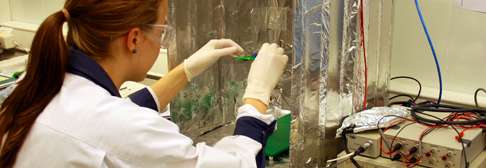Chronic pain and shaking under control using 'pacemaker for the brain'

How does electrical stimulation affect the brain? A project by Aalto University and the University of Helsinki, launched in early 2012, studies the impact mechanism of deep brain stimulation and develops electrochemical sensors for more effective measuring of neurotransmitters in the brain. The long-term goals of the research are more specific treatment for Parkinson's disease and many other diseases of the nervous system.
Deep Brain Stimulation (DBS) is a form of neurostimulation and means the application of electrical impulses to a certain part of the brain. The impulses are sent by an electrode implanted into the deepest part of the brain in a neurosurgical operation. The researchers believe that the stimulation releases neurotransmitters in the brain that either excite the nervous system or slow down its functions.
"In a way, DBS is like a pacemaker for the brain that provides instructions for the brain in regulating the amount of neurotransmitters", says the project leader, Professor Mervi Paulasto-Kröckel.
Stimulation of the deep parts of the brain has already been used in Finland for a long time to treat symptoms of severe neurological disorders. For example, with patients at an advanced stage of Parkinson's, it is possible to reduce the shaking and alleviate other symptoms by stimulating the brain to regulate the production of dopamine. The stimulation is also used to manage chronic pain.
However, the mechanisms of deep brain stimulation are not yet fully understood.
"Highly sensitive and fast-reacting sensors are needed to detect the impact of the stimulation. In the project, we develop the sensors and conduct experiments on how well they detect and identify different neurotransmitters in the brain using electrochemistry", Paulasto-Kröckel explains.
More thorough knowledge of the impact mechanisms would have many advantages: deep brain stimulation could be used as treatment more specifically, safely and effectively, and its impact on the brain could be targeted as accurately as possible. It is hoped that the use of less invasive, alternative treatment methods could be increased. A deeper understanding of the method would also enable the discovery of new applications.
"For example in the US, neurostimulation is now being used in the treatment of psychiatric disorders, such as severe depression and obsessive-compulsive disorder. The information obtained could advance development in many other fields of science, too, such as tissue technology making use of electrical impulses", says Paulasto-Kröckel.
The research group is currently exploring material solutions for electrodes.
"We are particularly interested in carbon-based electrode materials, such as diamond-like carbon (DLC), graphene, boron-doped diamond (BDD) and carbon nanotubes. Using DLC-coated electrodes, we have now been able to measure dopamine concentrations at the micromole level. In the project, we also explore the possibility of immobilising enzymes needed in the measuring of glutamate on top of different composite carbon materials", explains Docent Tomi Laurila.

















